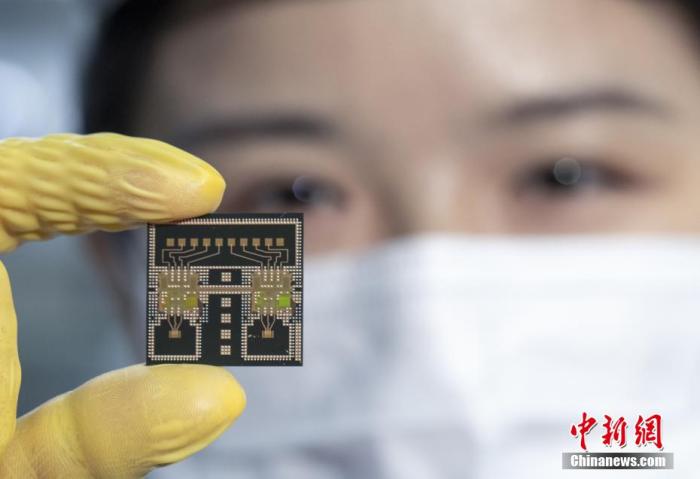(Mid-Year Economic Observation) Cracking the "Lack of Chips" China's semiconductor industry is booming
China News Service, Beijing, July 14 (Reporter Liu Yuying) To solve the "shortage of core" difficulties, in the first half of 2021, China's semiconductor industry will usher in many favorable policies and funds.
According to statistics from the China Semiconductor Industry Association, in the first quarter of 2021, China's integrated circuit industry sales were 173.93 billion yuan (RMB, the same below), a year-on-year increase of 18.1%.
Data map: R&D personnel are demonstrating 77GHz millimeter wave chip modules made in Anhui.
Photo by Xu Hao
According to statistics from the General Administration of Customs, China imported 155.27 billion integrated circuits in the first quarter of 2021, a year-on-year increase of 33.6%.
73.7 billion integrated circuits were exported, a year-on-year increase of 42.7%.
Although the data for the second quarter has not yet been released, the boom in supply and demand will continue.
Li Ke, vice president of CCID Consulting, said in an exclusive interview with a reporter from China News Agency that in the first half of this year, the entire industry was accelerating, both globally and in China, with booming prosperity and exceeding expectations.
However, with the boom in supply and demand, there are still structural shortages, such as automotive chips, GPUs, and mobile phones, which have not been alleviated in the first half of this year.
This is mainly due to factors such as US sanctions, the epidemic, and mismatches between supply and demand.
Li Ke said that the strategic importance of the semiconductor industry continues to be highlighted, and governments of all countries have paid unprecedented attention to it. The support from the United States, the European Union, Japan, South Korea and other countries is very prominent. China has also issued a number of support policies to solve the "chip shortage". problem.
Last year, China issued a number of policies to promote the high-quality development of the integrated circuit industry and software industry in the new era. It has formulated a policy framework in terms of finance and taxation, investment and financing, import and export, talents, etc. The supporting measures are being implemented one by one.
At the beginning of July, the Ministry of Industry and Information Technology, the China Securities Regulatory Commission and other six departments issued policies that will increase the research and demonstration applications of key core technologies, products, and equipment in the fields of basic parts, basic electronic components, integrated circuits, etc.; Important industries related to national security and the lifeblood of the national economy will accelerate their deployment in key links and mid-to-high-end areas.
It is worth mentioning that after many years of appeals from industry insiders, integrated circuit science and engineering became a first-level discipline in the first half of the year, which means that the entire discipline system will be re-adjusted according to industry requirements and will help alleviate the talent gap in the integrated circuit industry.
The place is also actively following up.
Anhui Province, Jiangsu Province, Shanghai in the Yangtze River Delta region of China, Jiangxi Province, Fujian Province, Guangdong Province, Sichuan Province in the Pan-Pearl River Delta region, etc., have all established clear goals for the development of integrated circuits during the "14th Five-Year Plan" period. A clearer cluster development plan was established.
According to incomplete statistics from the third-party organization Jiwei in the semiconductor field, in the first half of 2020 alone, 21 provinces have implemented more than 140 related projects, and the total investment has been disclosed to exceed 307 billion yuan.
Driven by policies, China's semiconductor industry has seen surging funds.
The registered capital of the second phase of the National Integrated Circuit Industry Investment Fund established in 2019 reached 204.15 billion yuan, spurring private investment several times.
Whether A-shares are in the primary or secondary markets, chip companies are enthusiastically sought after by funds.
Li Ke said that from the performance of the first quarter of this year, the stock prices of listed A-share chip companies are supported by performance.
At present, China's chip manufacturing capacity is accelerating its expansion.
The International Semiconductor Industry Association (SEMI) reported that by the end of this year, global semiconductor manufacturers will begin building 19 high-capacity fabs; in 2022, there will be an additional 10 fabs worldwide.
Of these, 8 are in mainland China and 8 are in Taiwan.
"For a wafer fab, it takes about 18 months from plant construction to commissioning, and another 18 months from reaching full capacity. In the foreseeable future, China's chip production capacity will increase substantially," said Li Ke. "The 14th Five-Year Plan During the period, emerging fields such as 5G communications, VR/AR, Internet of Things, artificial intelligence and brain-like computing, and autonomous driving will become important driving forces for the development of the integrated circuit market.
Li Ke believes that China is the world's largest integrated circuit market, demand continues to rise, wafer manufacturing capacity continues to expand, mainland China is undertaking the third semiconductor industry transfer, and high-quality local companies have emerged one after another.
However, the epidemic is still the biggest influencing factor in the short term.
Li Ke said that on the one hand, the epidemic has prevented the flow of personnel in the industry, and on the other hand, it has caused an impact on all aspects of design, manufacturing, and packaging.
The spread of the epidemic around the world one after another, the impact on the semiconductor industry has not seen any signs of mitigation so far.
(Finish)

